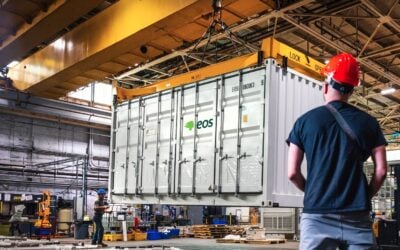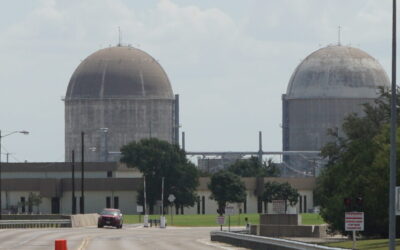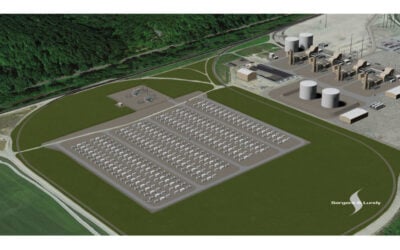
The US Department of Energy (DOE) has shortlisted the projects to receive US$325 million for long-duration energy storage (LDES), with technology providers including Energy Dome, Invinity, Form Energy and Redflow.
The grant funding will go to a total of 15 projects across the US which are deploying technologies that provide 10 or more hours of energy storage discharge at full power, the DOE’s definition of LDES.
Enjoy 12 months of exclusive analysis
- Regular insight and analysis of the industry’s biggest developments
- In-depth interviews with the industry’s leading figures
- Annual digital subscription to the PV Tech Power journal
- Discounts on Solar Media’s portfolio of events, in-person and virtual
The government department aims to reduce the cost of LDES by 90% by 2030, and the funding aims to help companies overcome the technical and institutional barriers to full-scale deployment of LDES technologies.
LDES is widely agreed to be needed in order to integrate intermittent renewable generation as it passes 50% of the energy mix, but technologies have been slow to commercialise due to higher upfront costs and less of a track record than the industry incumbent for energy storage, lithium-ion technology.
The funding applicants still need to undergo a negotiation process with the DOE, which can still cancel negotiations and rescind the funding for any reason, though the process is expected to be wrapped up before the end of 2023.
“As we build our clean energy future, reliable energy storage systems will play a key role in protecting communities by providing dependable sources of electricity when and where it’s needed most, particularly in the aftermath of extreme weather events or natural disasters,” said US Secretary of Energy Jennifer M. Granholm.
“Thanks to President Biden’s Investing in America agenda, DOE is supporting game-changing energy storage projects across the nation—laying the foundation for the innovative solutions we need to ensure stronger, more resilient communities.”
LDES projects from Energy Dome, Invinity, Redflow and Form Energy
Nine projects won a total of US$286 million from the LDES Funding Opportunity while another six won US$39 million under the LDES Lab Call funding opportunity for projects deployed at national labs.
Noteworthy among the first group are new projects which will utilise the vanadium redox flow battery (VRFB) technology of Invinity Energy Systems and the carbon dioxide-based technology of Italy-based Energy Dome.
The DOE plans to fund six projects totalling 84MWh of energy storage capacity using Invinity’s latest VRFB product, Mistral, with deliveries expected in 2025.
Five of the six, totalling 72MWh, will be developed by a consortium led by the National Renewables Cooperative Organisation, supported by Invinity and national lab Pacific Northwest National Laboratory (PNNL). The DOE’s funding will be used alongside matching funds from NCRO consortium partners to purchase, install and operate the VRFB units at projects operated by co-operative utilities in the Midwest and Southwest.
The five will have nominal discharge ratings of 700kW to 3.6MW and discharge capabilities of up to 20 hours, the DOE said.
The sixth was part of the US$39 million Lab Call opportunity, and will be deployed at PNNL’s headquarters for demonstration over a 10-year period.
Invinity expects the price of its Mistral units for these projects to be a third more competitive than recent sales of its previous-generation product, the VS3, while still being sold at a gross profit margin in support of its long-term industrial strategy. It announced its first order for Mistral just last week.
Meanwhile, a proposed 200MWh project from utility Alliant Energy – Columbia Energy Storage Project – using the proprietary ‘CO2 Battery’ technology from Energy Dome has also been shortlisted for US$30 million funding.
The project is planned for a site in Portage, Wisconsin, near a coal plant Alliant operates, with construction planned for 2025 and completion in 2026.
Energy Dome’s technology uses a thermodynamic cycle, charging by drawing carbon dioxide from a ‘Dome’ gasholder, storing it under pressure, and then dispatching by evaporating and expanding the gas through a turbine back into the gasholder. The company recently completed a two-part Series B, raising nearly US$60 million.
Another winning project will see microgrid integrator Faraday Microgrids install a 34.4MWh behind-the-meter energy storage system at a hospital in Madera, California, using the zinc bromide flow battery technology from Australia-based company Redflow.
It will be Redflow’s largest project to date. CEO Tim Harris recently spoke to Energy-Storage.news about what was then its largest to-date, a 20MWh system also in California.
Another project, this time from NextEra Energy Resources, one of the largest BESS integrators and operators, will also use zinc bromide technology at multiple renewable generation facilities in the Pacific Northwest and Upper Midwest. The DOE didn’t reveal any other technology provider for that project.
Two previously-announced projects by utility Xcel Energy using the iron-air battery technology of Form Energy have also been shortlisted for the DOE funding.
Other projects: second life batteries and zinc-based tech
Two separate projects employing second life technology – repurposing used EV batteries into stationary energy storage systems (ESS) – have also been selected for the funding.
Smartville Inc, which Energy-Storage.news interviewed last year, will receive funding to install systems using its latest product in partnership with various universities and corporations, while second-life diagnostics and re-use firm Rejoule won funding for a similar mix of projects.
Zinc manganese dioxide battery provider Urban Electric Power will supply its technology for two sites totalling 600kw/7.2MWh in New York, in partnership with the utility New York Power Authority.
The final project to have been shortlisted for funding is the Pumped thermal energy stOrage in ALaska Railbelt (POLAR) project, a partnership between nuclear power firm Westinghouse Electric Company LLC and waste heat recovery firm Echogen.
It will be in Alaska’s Railbelt region and will be combined with the development of wind power.
Read a full list and descriptions of the winning projects on the DOE site here.






